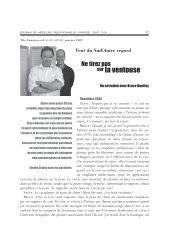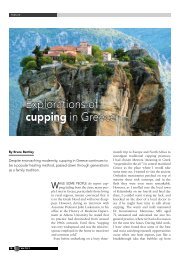Cupping Deficiency - Australian School of Traditional Thai Massage
Cupping Deficiency - Australian School of Traditional Thai Massage
Cupping Deficiency - Australian School of Traditional Thai Massage
Create successful ePaper yourself
Turn your PDF publications into a flip-book with our unique Google optimized e-Paper software.
24<br />
feature<br />
n <strong>Thai</strong> clay pots for cooking<br />
that double as hot–pressing<br />
implements, sitting on top <strong>of</strong><br />
furnaces.<br />
Vol 8-2<br />
the inside. I use a type <strong>of</strong> glass cup that<br />
is manufactured in Vietnam. The main<br />
body <strong>of</strong> the cup is thinner than cups<br />
produced in China, and the lip is also<br />
quite thin, smooth and nicely curved. The<br />
comparative thinness <strong>of</strong> these cups allows<br />
me to efficiently heat the inside <strong>of</strong> the cup,<br />
which then radiates to the external surface.<br />
The curved glass is very smooth and even,<br />
so the surface can be used as a heating<br />
massage tool to good effect.<br />
Procedure: A flame is introduced inside<br />
the cup and held there while the operator<br />
twirls the cup around with the other hand.<br />
At intervals (after every few seconds),<br />
remove the flame and turn the cup around<br />
and return the flame again into the twirling<br />
cup repeatedly, until the heat has conveyed<br />
throughout the cup’s entire surface area.<br />
The practitioner must check that the level <strong>of</strong><br />
heat is not so extreme to cause discomfort<br />
or a burn.<br />
Comments: As I have never seen or<br />
read about the technique <strong>of</strong> heating the<br />
cup surface to then use as a warming<br />
instrument, I call it the “hot-pressing<br />
cupping (method)” or yun guan (fa). I have<br />
coined this name because it is a modification<br />
<strong>of</strong> an ancient method <strong>of</strong> hot-pressing (yun)<br />
first described in the Mawangdui Medical<br />
Manuscripts (MMM), which were written<br />
circa 168 BC and discovered within tombs<br />
in Hunan Province in the early 1970s. The<br />
Chinese character yun means an iron<br />
used to press, to take the creases out <strong>of</strong><br />
material. The character has a fire radical,<br />
which designates heat as being essential<br />
to its modus operandi. Therefore it is the<br />
use <strong>of</strong> a heated implement or object that<br />
is pressed down onto the body. Judging<br />
from its frequent recommendation for<br />
employment in the MMM, hot-pressing<br />
played a significant role in the therapeutics<br />
<strong>of</strong> its day.<br />
One example is the use <strong>of</strong> heated oblong<br />
stones that have been “quenched in vinegar<br />
and then used to hot press” (Harper, 1998,<br />
p. 97). This is interesting as well because it<br />
is a predecessor <strong>of</strong> sorts to Step 2 to follow,<br />
which combines heat with medicinal fluid,<br />
or in our case, following heat therapy with<br />
the application <strong>of</strong> medicated liniment.<br />
While in Vietnam I was told <strong>of</strong> a modern<br />
context for this ancient therapy as well.<br />
During the Vietnam War, those Vietnamese<br />
soldiers in the jungle in the grip <strong>of</strong> malaria<br />
and chilled to the core would lie on heated<br />
stones and have them placed on top <strong>of</strong> their<br />
body as well.<br />
Another variation <strong>of</strong> hot-pressing in the<br />
MMM requires an iron pan filled with<br />
“scorched salt” when used for therapeutic<br />
purposes – otherwise in ordinary life,<br />
the same pan was filled with hot coals for<br />
ironing. It was used “when an ailment first<br />
lodges on the surface <strong>of</strong> the body and has<br />
not penetrated deeply inside” (Harper,<br />
1998: p. 229). I interpret this as not going<br />
so deep as to penetrate the organs.<br />
In the province <strong>of</strong> Isaan, in North-Eastern<br />
<strong>Thai</strong>land, I have seen heat conveyed into<br />
the body using a clay pot half filled with<br />
hot salt, which is then pressed on specific<br />
sites and points. One <strong>of</strong> the functions<br />
<strong>of</strong> this method is to warm up a woman<br />
after her body has become cold following<br />
childbirth.<br />
Yun also denotes “moving” like one does<br />
using an iron over material. So too with a<br />
glass cup, it needs to be shifted and rolled<br />
on the skin surface and not left in one place<br />
long enough to scald.<br />
It would be rather amiss not to mention<br />
that, to date, the first textual evidence <strong>of</strong><br />
cupping in China is to be found in the<br />
Mawangdui texts. <strong>Cupping</strong> is referred to<br />
as “the horn method”, which testifies to<br />
hollowed-out animal horns being used as




